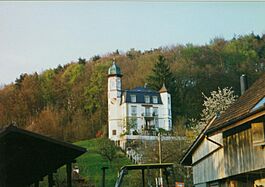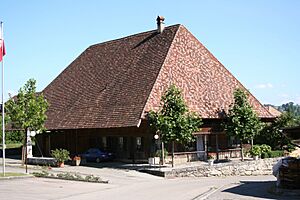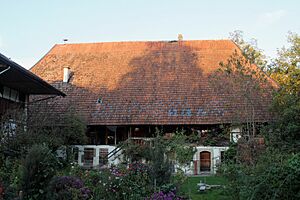Dotzigen facts for kids
Quick facts for kids
Dotzigen
|
||
|---|---|---|

Dotzigen Castle near the village
|
||
|
||
| Country | Switzerland | |
| Canton | Bern | |
| District | Seeland | |
| Area | ||
| • Total | 4.23 km2 (1.63 sq mi) | |
| Elevation | 435 m (1,427 ft) | |
| Population
(Dec 2020 )
|
||
| • Total | 1,490 | |
| • Density | 352.2/km2 (912/sq mi) | |
| Postal code |
3293
|
|
| Surrounded by | Büetigen, Schwadernau, Scheuren, Meienried, Büren an der Aare and Diessbach bei Büren | |
Dotzigen is a small town, also called a municipality, in Switzerland. It is located in the Seeland area of the canton of Bern.
Contents
History of Dotzigen
Dotzigen was first written about in 1182. Back then, it was called Tocingen.
The very first signs of people living in Dotzigen are six Hallstatt grave mounds. These are ancient burial sites found on the Dotzigenberg hill. Later, during the Roman times, a settlement was built near where the village is today.
In the Middle Ages, Dotzigen was part of a territory called Strassberg. This land was bought by Bern in 1393. Dotzigen then became part of the local court of Diesbach, which was in the area controlled by Büren.
The village church, St. Mauritius, was first mentioned in 1242. After the Protestant Reformation (a big change in religion), Bern took control of the church in 1531. The church's local area, called a parish, was then closed. Dotzigen became part of the church area of Büren, and later of Diessbach.
Dotzigen was on the road between Büren and Aarberg. People living there traded goods with these towns. They also ran a place where travelers could rest. In the 1800s, projects to control the Aare River, called the Jura water correction, helped stop floods. These projects protected the village from damage.
In 1876, a railroad line connected Dotzigen to bigger cities like Solothurn and Lyss. This easy transport helped businesses grow in Dotzigen. A place to make alcohol opened in 1888. A brick factory started in 1891, and a furniture factory in 1898. Even with these jobs, most people (over two-thirds) traveled to work in other towns like Biel, Lyss, and Grenchen in 2000. The historic Schlössli (a small castle) outside the village was built in 1898 by a brick maker named Johann Schaller.
Geography of Dotzigen
Dotzigen covers an area of about 4.25 square kilometers (1.64 square miles). A large part of this land, about 55.7%, is used for farming. Forests cover about 26.1% of the area. Buildings and roads make up about 14.9% of the land. Rivers and lakes cover about 2.1%, and a small part (1.2%) is land that cannot be used.
Most of the built-up area is for houses and buildings (7.8%). Industrial buildings take up 1.7%, and roads take up 3.8%. Parks and sports fields make up 1.4%. All the forested land is covered with thick forests. For farming, 46.2% is used for crops. About 7.3% is used for pastures where animals graze. A small part (2.1%) is for orchards or vineyards. All the water in Dotzigen is from flowing rivers.
Dotzigen is located in the Seeland region. It sits at the western edge of the Dotzigen/Stedtli Mountains. To the west, the Old Aare river flows. This is a part of the Aare River that changed course after the Jura water correction projects. This area is now a protected floodplain, which means it's a flat area next to a river that can flood. The Jura water correction helped the town grow in the flat parts of the municipality.
On December 31, 2009, the old district of Büren, where Dotzigen was located, was closed. The next day, January 1, 2010, Dotzigen became part of the new Seeland administrative district.
Dotzigen's Coat of Arms
The blazon (description) of Dotzigen's coat of arms is simple. It shows a red shield with a silver top part. In the silver top part, there is a red star.
People and Population (Demographics)
Dotzigen has a population of about 1,300 people. As of 2010, about 6.2% of the people living there were foreign nationals (people from other countries). Over the past 10 years (2000-2010), the population has slightly decreased by about 2.1%. This was mainly because more people moved away than moved in.
Most people in Dotzigen (about 93.7%) speak German as their main language. French is the second most common language (1.5%), and Italian is third (0.9%).
As of 2008, about 49.9% of the population were men and 50.1% were women. Most people (about 71.6%) were Swiss citizens. About 28.8% of the people living in Dotzigen in 2000 were also born there. Many others were born in the same canton (42.8%) or elsewhere in Switzerland (14.6%). About 9.0% were born outside Switzerland.
As of 2010, children and teenagers (ages 0–19) make up 21.2% of the population. Adults (ages 20–64) make up 65%, and seniors (over 64) make up 13.8%.
In 2000, about 562 people in Dotzigen were single and had never been married. There were 682 married people, 80 widows or widowers, and 67 divorced people.
In 2000, there were 118 households with only one person. There were also 36 households with five or more people. Most apartments (92.1%) were lived in all the time. A small number (3.4%) were used only at certain times of the year, and 4.5% were empty. In 2011, about 2.56% of homes were empty.
The chart below shows how Dotzigen's population has changed over time:

Interesting Sights
The famous writer Jeremias Gotthelf once wrote about the sour wine from Dotzigen. This wine still grows at the foot of the mountains near the town.
At the base of the Dotzigen Mountains, there is a small castle. It is known for its special roof made of gilded (gold-covered) copper. As you leave the town towards Diessbach, you can find an old flour mill. This mill used to be powered by a large water wheel. It has been fixed up and visitors can see it by making a reservation. This old mill is very important and is listed as a Swiss heritage site of national importance.
Economy and Jobs
In 2011, Dotzigen had a low unemployment rate of 1.87%. This means most people who wanted jobs had them. In 2008, there were 525 people working in the town.
Jobs are divided into three main types:
- Primary sector: This includes jobs that get raw materials from nature. In Dotzigen, 28 people worked in this sector, mostly in farming. There were 11 businesses in this area.
- Secondary sector: This includes jobs that make things. In Dotzigen, 48 people worked here. Most of them (56.4%) were in manufacturing (making goods), and others (43.6%) were in construction (building things). There were 10 businesses in this sector.
- Tertiary sector: This includes jobs that provide services. In Dotzigen, 449 people worked in this sector. Many (70.6%) worked in sales or car repair. Some (4.6%) worked in education, and others (20.7%) worked in healthcare. There were 36 businesses in this sector.
In 2000, 295 workers came into Dotzigen for their jobs. However, 572 workers left Dotzigen to work in other towns. This means more people from Dotzigen work outside the town than people from outside work in Dotzigen. Of the people who worked, 13.4% used public transport to get to work. A much larger number, 59.9%, used their own car.
Religion in Dotzigen
Based on a survey from 2000, most people in Dotzigen belong to a Christian church. About 11.9% were Roman Catholic. A larger group, 74.2%, belonged to the Swiss Reformed Church.
A small number of people belonged to other Christian churches. For example, about 0.36% were Orthodox Christians, and 4.10% belonged to other Christian groups. There were also 31 people (about 2.23%) who were Islamic. A few people (6) were Buddhist. About 5.90% of the population said they did not belong to any church, or were agnostic (not sure about God) or atheist (do not believe in God).
Education in Dotzigen
In Dotzigen, about 41.1% of the people have finished upper secondary education. This is schooling after primary school but before university. About 9.1% have gone on to higher education, like a university or a special college called a Fachhochschule.
The school system in the Canton of Bern works like this:
- One year of non-required Kindergarten.
- Six years of Primary school.
- Three years of required lower Secondary school. Here, students are grouped based on their skills.
- After lower Secondary, students can continue their education or start an apprenticeship (learning a trade on the job).
During the 2009-2010 school year, 222 students went to school in Dotzigen. There was one kindergarten class with 24 students. The town had 4 primary classes with 65 students. There were also 7 lower secondary classes with 133 students.
In 2000, 84 students came to Dotzigen to attend school from other towns. At the same time, 52 students from Dotzigen went to schools outside the town.
Transportation
Dotzigen was connected to the Swiss railway system in 1876. This happened when the Solothurn-Lyss-Bahn railway line was built. Today, trains from Dotzigen go to Büren an der Aare or Kerzers. You can also reach Dotzigen by car using the A5 highway, which connects Solothurn and Biel.
See also
 In Spanish: Dotzigen para niños
In Spanish: Dotzigen para niños








